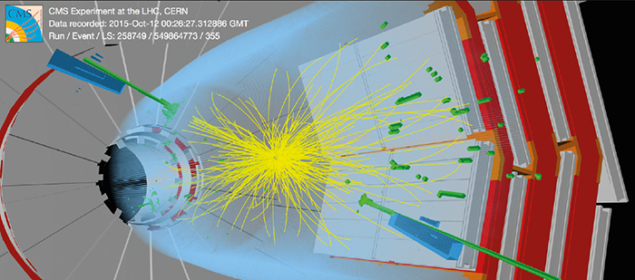The first phase of collisions after the LHC restart earlier this year provided CMS with data at the novel energy of 13 TeV, enabling CMS to explore uncharted domains of physics. At the end of this exciting year, CMS and ATLAS presented comprehensive overviews of their latest results from analyses performed on the collected data. Here we highlight only a few of the key CMS results – refer to the further reading (below) for more.

Before exploring the “unknown”, CMS first strove to rediscover the “known”, as a means to validate the excellent performance of the detector after emerging from the consolidation and upgrade period of Long Shutdown 1. Convincing performance studies as well as early measurements had already been presented at this year’s summer conferences. Meanwhile, the studies and physics measurements continued as the size of the data sample increased over the course of the autumn. In total, CMS approved 33 new public results for the end-of-year jamboree, capping off a successful period of commissioning, data collection and analysis. In contrast to the studies performed for other Standard Model particles, CMS preferred to remain blinded for studies involving the LHC’s most famous particle, the Higgs boson discovered in 2012, because the collected data sample was not large enough for a Higgs boson signal to be detectable.
However, it was the anticipation of results on searches for new phenomena that filled CERN’s main auditorium beyond capacity. The CMS focus was on searches that would already be sensitive to new physics with the small data sample collected in 2015. Hadron jets play a crucial role in searches for exotic particles such as excited quarks, whose observation would demonstrate that quarks are not elementary particles but rather composite objects, and for heavier cousins of the W boson. These new particles would demonstrate their presence by transforming into two particle jets (a “dijet”). The highest-mass dijet event observed by CMS is shown in the figure. In carrying out this study, CMS searches for bumps in the mass distribution of the dijet system. Seeing no significant excess over the background, a new CMS publication based on the 13 TeV data imposes limits on the masses of these hypothetical particles ranging from 2.6 TeV to 7 TeV, depending on the new-physics model.
CMS also searched for the presence of heavy particles such as a Z´ (Z-prime) boson in the dilepton spectrum, in which unstable exotic particles would transform into pairs of electrons or muons. While CMS observed high-mass events, with dielectrons up to a mass of 2.9 TeV and dimuons up to 2.4 TeV, the data are compatible with the Standard Model and do not provide evidence for new physics.
Finally, CMS observed a slight excess in events with two photons at a diphoton mass around 760 GeV. However, small fluctuations such as this have been observed regularly in the past, including at LHC Run 1, and often disappear as more data is collected. Therefore we are still far from the threshold associated with a new discovery, but the stage is set for great excitement and anticipation in the upcoming 2016 run of the LHC.







